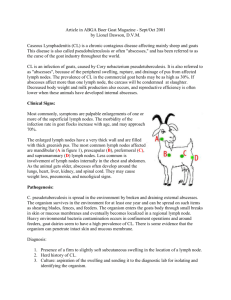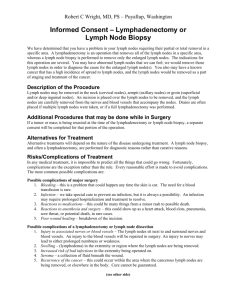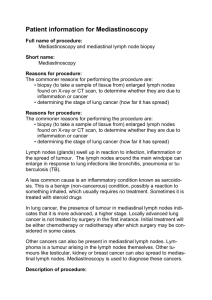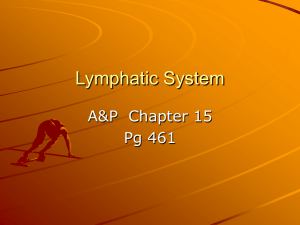Caseous lymphadenitis (CL)
advertisement
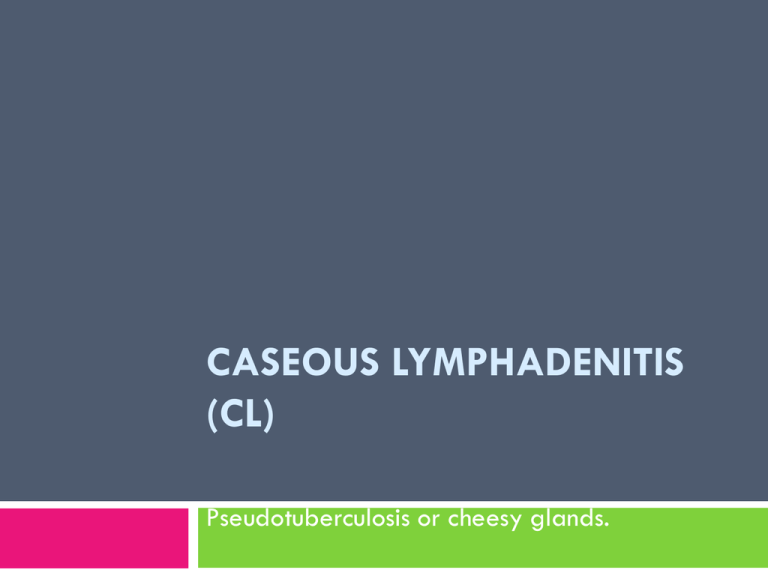
CASEOUS LYMPHADENITIS (CL) Pseudotuberculosis or cheesy glands. Definition It is a chronic debilitating infectious disease of sheep and goats, caused by corynebacterium pseudotuberculosis, characterized by suppurating, necrotizing inflammation of one or more lymph nodes (abscessation of lymph node). Etiology Corynebacterium (C) pseudotuberculosis is the specific cause of the disease. There are two proposed biotypes, ovine/caprine and equine/bovine. Variation in toxin production between strains may be related to differences in pathogenicity. C. pseudotuberculosis is intracellular, Gram positive, polymorphic rods, coccoid to filamentous, non-acid fast, aerobic to facultative anaerobic. It grow on blood agar giving pin point colonies of white or creamy-opaque, flat of matted surface with narrow zone of hemolysis within 1-2 days of incubation. Predisposing factors Dirty condition at shearing time, faulty shearing, dipping where the organism still lives for 24 h in sheep dip, abrasions, wounds from fighting or grass seeds. Epidemiology Distribution: Caseous lymphadenitis occurs in the major sheep-producing countries in the world including Australia, New Zealand, South Africa, the Middle East including Egypt Animal susceptibility: Sheep and goats of all ages but adults are more affected than young because repeated exposure to infection at shearing. CL is more serious in goats than in sheep. Epidemiology Mode of infection: Source of infection: The discharges from ruptured abscessed superficial lymph nodes and the nasal and oral secretions from animals with pulmonary abscesses draining into the bronchial tree. It contaminated shearing tools, dipping fluid, contaminated soils or contaminated surgical tools. Mode of transmission: Infection of an animal is facilitated by the presence of skin wounds but the organism can invade through intact skin. Transmission is by direct contact with infective discharges or mediated by contaminated shearing equipment, contaminated shearing shed boards or holding pens, contaminated dipping or shower fluids, or dust from contaminated shearing sheds and yards. Pathogenesis After infection, the organism is drain to local lymph nodes (within leukocytes), it multiply resulting in inflammation and multiple abscess formation which coalesce with each other and undergo encapsulation, the infected lymph node become consists of central necrotic mass of ct in the center surround by capsule from ct, inflammatory cells, the cells of inner layer of connective tissue capsule is killed by bacterial toxins and thus add a new layer of suppuration to the central necrotic mass and a new capsule, these process repeated resulting in onion ring appearance of the lesion. Blood born infection results in septicemia of lambs or abscess formation in adults in many organs as lung, liver, kidney, brain and spinal cord without appearance of lymphadenitis of superficial lymph nodes as in "Thin ewe syndrome" which is diagnosed in slaughter house. Clinical signs IP is unknown naturally (long up to 90 d), MB may be high in sheep (15-70%), Mt rate is low and course of the disease is long. Sheep Superficial form: There is palpable enlargement of one or more of the superficial lymph nodes (commonly affected are the submaxillary, prescapular, prefemoral and supramammary). The abscesses commonly rupture and thick green to caseated pus, with no odor, is discharged and onion-like which is soft firstly and then become dried later. Clinical signs Internal or Visceral form: In cases in which systemic involvement occurs, chronic pneumonia, pyelonephritis, ataxia. The debilitating disease of adult ewes commonly referred to as 'thin ewe syndrome' is often associated with the occurrence of internal abscesses. In ewes, local spread from the supramammary lymph node to the mammary tissue is common. The resulting fall in milk yields leads to poor growth and even death of lambs and this may be a serious economic feature in badly affected flocks. Clinical signs Goat: Abscess or scar tissue from healed abscess may be present under ears, superficial lymph nodes is enlarged (common affected lymph nodes is parotid), abscessate and may discharge greenish creamy pus Postmortem lesions: Carcass is emaciated, caseous abscess filled with greenish yellow pus chiefly in lymph nodes, in early stage pus is soft and pasty but later on become firm dry and characteristic laminated or onion-ring like appearance with layers of caseous materials separated by fibrous band on incision Abscess formation to lesser extent in internal organs as lung. Diagnosis Field diagnosis: It depends on clinical signs as suppurative lymphadenitis of superficial lymph nodes especially after shearing, docking, castration beside postmortem lesions, epidemiology of the disease and field allergic skin test. Laboratory diagnosis: Samples: Pus, biopsy of lymph nodes, parts of lymph nodes, blood and serum. Laboratory procedures: Examination of pus smears after staining with Gram stain to detect Gram positive, polymorphic rods organism. Culture on blood agar, incubation for 1-2 days at 37 C, colony appear as small pin point and off-white faintly hemolysis. Detection of toxins by inoculation of suspected materials I/D into rabbits, resulting in dermal necrosis. G. Pig inoculation I/V by pus, death after 4-10 days, with absecessation of lung and liver while I/P injection produce orchitis with abscess formation. Detection of antitoxins by IHT, ELISA, CFT or agglutination tests. Hematological and serum biochemical analysis. Treatment: The treatment is not satisfactory due to suppuration and cell wall lipids of organism. The C. pseudotuberculosis is susceptible to many antibiotics in vitro as pencillin, oxytetracyclin 10 mg/kg or procaine pencillin 22.000 IU/kg for 3-5 days. Surgical treatment, complete evacuation of pus and washing with antiseptic or total extraction of the infected nodes Control: Proper management: Isolation and culling of infected sheep. Sanitary care during shearing, castration or docking and use skin disinfection and disinfection of surgical instrument. Avoid contamination of dipping fluids so, dipping of lamb firstly, and then adult due to decrease chance of lamb infection. Vaccination: Immunization of goats or lambs with killed whole organism or with toxoid may helpful in limiting infection, sheep of one month age vaccinated by BCG show decrease incidence of the disease. There is no a available vaccine produced and used in Egypt.
